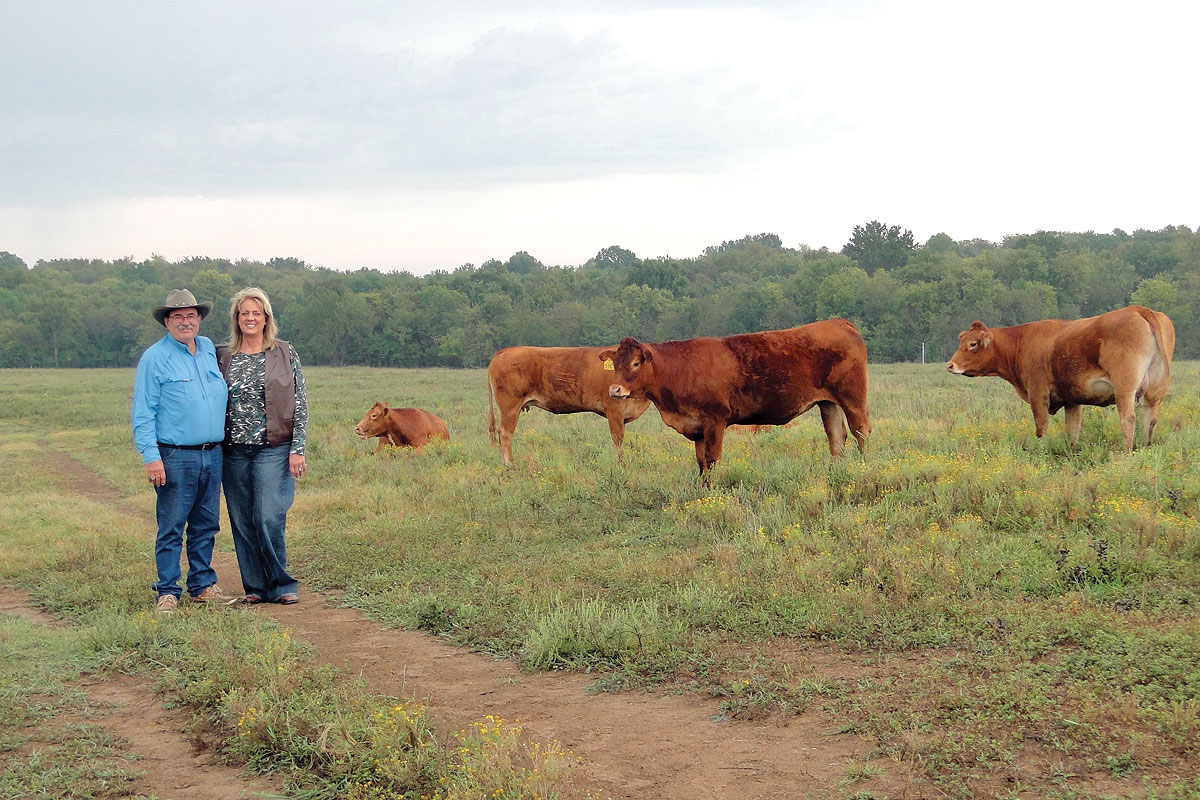
Kraig and Rhonda Withers began building their herd nearly two decades ago
Some teenage marriages not only survive but prosper. This is the case with Kraig Withers who married his high school sweetheart Rhonda Harris when they were only 19 and 17. The couple worked hard and developed a group of companies with Withco Constructors Inc., specializing in multi-housing as the flagship of the group and in addition to property and investment companies.
Regardless of their business success, both were raised in the country and wanted cattle of their own. Kraig was raised on a subsistence type ranch that sold milk and cotton from 50 acres while raising about everything else they needed. Rhonda, on the other hand, was raised on the Liston Ranch on the other side of town.
Kraig and Rhonda’s country adventure began with rodeos, horses and showing pigs with their two children, Keith and Kretia, rather than with raising cattle. Their cattle hobby started with Tiger Striped cattle purchased from friend Butch Hardesty’s Arrowhead Ranch in the early 2000s when some of his heifers were for sale. The Withers bought 15 heifers and an Angus bull to begin a commercial herd. They purchased Lim Flex and then next they purchased eight E6 bred heifers from Taft Prison between Muskogee and Haskell, Okla.
Those E6 heifers turned into good cows and seem to contain the best combination of fertility, milking ability, weight, confirmation, hardiness and disposition. While they subsequently disbursed their entire herd due to working out of state, they were not out of the cattle business for long.
In 2013, the couple decided to buy seven registered, full blood and just weaned Limousin heifers. Later, at a dispersal sale, they bought more full blood heifers, cows and a bull.
“The herd bull was my birthday present, much better than a fishing pole,” Rhonda said,
Limousins have an F94L gene found almost exclusively in the Limousin breed. That gene promotes growth, weight and feed efficiency as well as increasing tenderness. In addition, both Kraig and Rhonda like the red color.
“Our Limousins have been bred for docility and milk production. If they’re wild, they’re gone, so our herd is very tame,” Kraig said.
The Withers have 900 acres spread among two ranches with Diamond R Cattle Company serving at the center. They raise full-blooded Limousins and are starting to raise purebred with their son Keith, who is the project manager and the herdsman. Rhonda does the paperwork for the cattle, which is almost a full-time job at this time, as well as for their other businesses, while their granddaughter Kaitlynn shows cattle nationwide.
All cows are bred by AI with natural cover used for cleanup. They have contracted service from an experienced technician who now lives in Oklahoma and who achieves a 65 to 90 percent conception rate. Their intended market is commercial cattlemen with different buyers looking for different combinations of traits. Breeding by AI and using DNA analysis allows them to select those traits requested by larger buyers with much greater accuracy. Most commercial breeders want higher marbling. Consequently, the Withers offer a variety of genetic patterns with an average easy birth weight around 70 pounds, good milking, docility, feed efficiency with the highest yield and good growth rate being required traits.
For more than 40 years, the United States has not allowed African cattle into the country. Rhonda has spent the last two and a half years trying to get some of those genetics into their herd for greater diversity while abiding by all regulations with the first calves with those genetics due Oct. 26.
The Withers sell by private treaty and have not had an excess to constitute an on-site sale thus far though they are hoping to have one in 2018. They sell no bull under one year of age and are in the process of increasing their herd by 20 percent in order to be able to sell open and bred heifers next April. After DNA genetic breeding, the first criteria for culling is by confirmation because individual differences are unavoidable and eye appeal is important in breeding stock.
Calves are weaned at 6 months of age, at 550 to 650 pounds. All cattle are offered free choice granular minerals in addition to mineral and salt blocks. In the summer, they are grained twice a week in order to retain docility. Winter rations are as much as is needed. The Withers use a 14 percent protein mixed ration supplemented their own hay as needed. The cattle are worked in April and October with ear tags used for flies and supported by spraying during fly season as well as vaccinations, tattooing, etc., as needed.
“While Keith sees the cattle every day, I like to put an eye on them at least every two or three days and want to see them fat and sassy, well, perhaps not really sassy but happy,” Rhonda said.
The Withers have land with native grasses and Bermuda in addition to the 160-acre hay meadow of all native grasses and produce 550 bales in a good year. Kraig prefers to keep 200 extra bales on hand for a bad winter or dry summer. Because the land is self-sufficient fertilizing dragging and spraying for weeds are mostly unnecessary. Water is supplied by ponds, two of which are spring fed. Kraig built five ponds himself with a dozer, Kraig’s favorite ranching task.
Both Kraig and Rhonda feel time is their biggest challenge which means they are especially appreciative of Keith’s role as ranch manager and Kaitlynn’s daily help. Kertia and her husband along with their two children Gus and Kragen are also involved. This is definitely a family affair.






